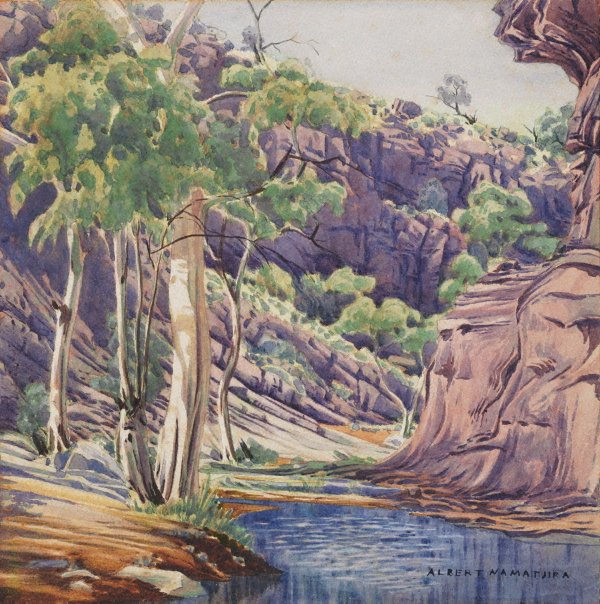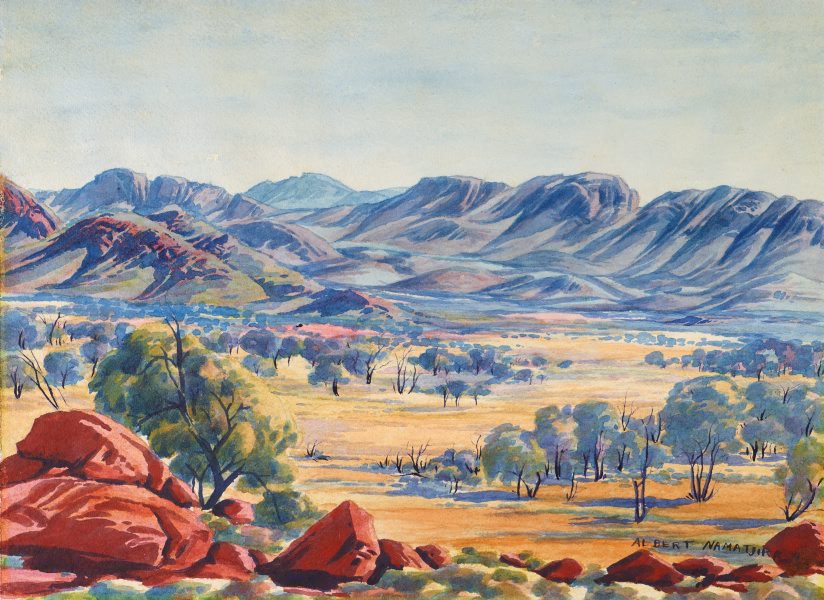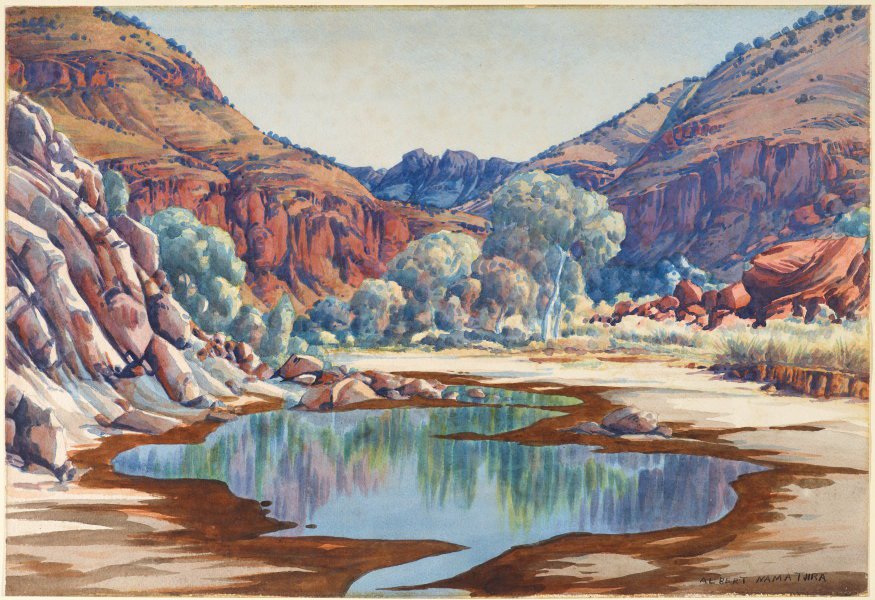Biography
-
Milner, J. (n.d.).Iconic and Influential Arrente Artist .https://www.nfsa.gov.au/latest/albert-namatjira-his-life-and-art
 The work of influential Arrernte artist, Albert Namatjira features in our Aboriginal and Torres Strait Islander Artists curated collection. Johnny Milner takes a closer look at Namatjira, who used his art as a vehicle to help bring about political reform. In life and through his art, Namatjira tried to navigate the divide between Aboriginal and Western cultures.
The work of influential Arrernte artist, Albert Namatjira features in our Aboriginal and Torres Strait Islander Artists curated collection. Johnny Milner takes a closer look at Namatjira, who used his art as a vehicle to help bring about political reform. In life and through his art, Namatjira tried to navigate the divide between Aboriginal and Western cultures.
Work History
-
Artists Footsteps. (2000). The Artists. https://www.artistsfootsteps.com/html/Namatjira_biography.htm
 1902: Albert Namatjira was a full-blooded member of the Western Aranda (Arunta) tribe, and his birth was registered at the Hermannsburg Lutheran Mission on July 28, 1902.
1902: Albert Namatjira was a full-blooded member of the Western Aranda (Arunta) tribe, and his birth was registered at the Hermannsburg Lutheran Mission on July 28, 1902.
Those who have studied the Western Aranda now note that within this tribal area there is a tribal kinship system with eight recognizable groups or skins. These comprise the Kngwarriya, Piltharra, Mpitjana, Ngala, Purrula, Panangka, Purianda and Kumarra.
Albert was of the Kngwarriya skin, while his father Namatjira, who was born near the Ormiston Gorge was of the Piltharra skin and his mother Ljukuta, who was born near Palm Valley was of the Mpitjana skin. Albert was the first born son in his family. -
ManyHandsArtCentre. (2024). Albert Namatjira (1902 – 1959).https://manyhandsart.com.au/about/albert-namatjira/
 Albert Namatjira is one of Australia’s great artists, and perhaps the best known Aboriginal painter. His western style landscapes – different to traditional Aboriginal art, made him famous. Fame led to Albert and his wife becoming the first Aborigines to be granted Australian citizenship. It was a significant achievement, because at this time Aborigines had few rights. He wasn’t born Albert Namatjira. His parents called him Elea. But after moving to an Aboriginal mission (Hermannsburg) and adopting Christianity, they baptised and renamed their son.
Albert Namatjira is one of Australia’s great artists, and perhaps the best known Aboriginal painter. His western style landscapes – different to traditional Aboriginal art, made him famous. Fame led to Albert and his wife becoming the first Aborigines to be granted Australian citizenship. It was a significant achievement, because at this time Aborigines had few rights. He wasn’t born Albert Namatjira. His parents called him Elea. But after moving to an Aboriginal mission (Hermannsburg) and adopting Christianity, they baptised and renamed their son.
Quotes
-
ArtQuotes. (2022). Albert Namatjira Quotes on Art. https://www.artquotes.net/albert-namatjira-quotes-on-art/
 Albert Namatjira is a famous Australian Aboriginal painter. He is a Western Arrernte artist best known for his watercolor landscape paintings of the Australian outback. Famous Albert Namatjira works include “Central Australian Landscape”, “Standley Chasm”, “Hermannsburg Mission with Mt Hermannsburg in Background”, “Haasts Bluff”, “Macdonnell Ranges”, and “Ghost Gums, James Range”.
Albert Namatjira is a famous Australian Aboriginal painter. He is a Western Arrernte artist best known for his watercolor landscape paintings of the Australian outback. Famous Albert Namatjira works include “Central Australian Landscape”, “Standley Chasm”, “Hermannsburg Mission with Mt Hermannsburg in Background”, “Haasts Bluff”, “Macdonnell Ranges”, and “Ghost Gums, James Range”.
Evaluation
-
Glessner, L. (2022). 3 Essential Art Evaluation Questions. https://lorraineglessner.wordpress.com/2018/05/15/3-essential-art-evaluation-questions/
 What attracts you to this work? What makes you cross the room to take a closer look? Detail, use of color, drama, movement, materials, pattern, ornament, gesture, visual poetry, repetition, raw emotion, deconstruction, drawing and line.
What attracts you to this work? What makes you cross the room to take a closer look? Detail, use of color, drama, movement, materials, pattern, ornament, gesture, visual poetry, repetition, raw emotion, deconstruction, drawing and line. -
KateOwenGallery. (2024). A Guide To Buying Aboriginal Art. https://www.kateowengallery.com/page/A-Guide-to-Buying-Aboriginal-Art#:~:text=Provenance%20can%20take%20many%20forms,of%20the%20artist%20painting%20the
 Provenance can take many forms – it could be a signed certificate or statement of authenticity from a respected authority, an exhibition or gallery sticker attached to the art, an original gallery sales receipt, an appraisal from a recognised authority or expert on the artist, and images of the artist painting the artwork.
Provenance can take many forms – it could be a signed certificate or statement of authenticity from a respected authority, an exhibition or gallery sticker attached to the art, an original gallery sales receipt, an appraisal from a recognised authority or expert on the artist, and images of the artist painting the artwork. -
JapingkaAboriginalArt. (2014). Buying Aboriginal Art: From First Time Buyers to Collectors. https://japingkaaboriginalart.com/articles/buying-aboriginal-art/
 To me it is that all that variety, the depths of meaning that is so valuable. As a non-initiated Westerner, I’ll never know the full story behind aboriginal art. You have to be fully initiated to be privy to particular Dreaming Stories. Usually I find that the artist wants you to share in what can be shared. I guess that’s why I like it. They can tell you quite a lot about it without breaching their codes. To me it works on two levels. It works in this level of a story if you like, but aboriginal art can also work as abstract art. It’s not abstract art, but it definitely works on that level and that sometimes the first way that people are initially drawn to Aboriginal art. They see a painting, they just love the palette, the composition, the scale, the depth. They don’t know anything about the story, but they love the painting.
To me it is that all that variety, the depths of meaning that is so valuable. As a non-initiated Westerner, I’ll never know the full story behind aboriginal art. You have to be fully initiated to be privy to particular Dreaming Stories. Usually I find that the artist wants you to share in what can be shared. I guess that’s why I like it. They can tell you quite a lot about it without breaching their codes. To me it works on two levels. It works in this level of a story if you like, but aboriginal art can also work as abstract art. It’s not abstract art, but it definitely works on that level and that sometimes the first way that people are initially drawn to Aboriginal art. They see a painting, they just love the palette, the composition, the scale, the depth. They don’t know anything about the story, but they love the painting.
Explore Their Work -1

ANSW. (n.d.) Catherine Creek. https://www.artgallery.nsw.gov.au/collection/works/358.2001/
Explore Their Work -2

ANSW. 9n.d.) North Ranges looking south. https://www.artgallery.nsw.gov.au/collection/works/81.1997/
Explore Their Work -3

ANSW. (n.d). Palm Valley. https://www.artgallery.nsw.gov.au/collection/works/93.1986/